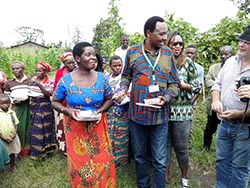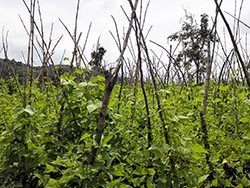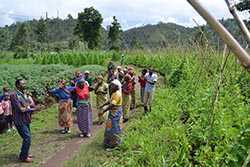In the morning of May 17th buses took all participants of the Annual Planning Meeting through a hilly landscape to two sites in Northern Rwanda that were first approached by N2Africa back in 2010.
Gahunga action site
The first visit was to a farmers’ organisation called Turwanyinzale (‘fight hunger’) in the Gahunga action site (cell: Rwasa, village Mutara) where we were warmly received with song and dance. Jacques Hakizimana Rwibasira (coordinator of the Department of Rural Development (DRD)) introduced the group which consisted of 19 females and 19 males, managing 60 hectares of land in a rotation of beans (first season) and maize (second season).
|
They try out various varieties of climbing beans including the following:
|

showing varieties of climbing beans |
Ms. Gasilida explained that climbing beans perform better than other crops in this region. The group of farmers started out years ago with local varieties and they approached DRD when they learned that DRD was experimenting with improved varieties. With these new varieties the bean yield increased from one bag of 100 kilograms to three bags and a half!
Upon receiving training from N2Africa in 2010, the farmers began to further cooperate among themselves and they started to produce climbing beans on a large scale on an area of 30 hectares. All farmers marked the boundaries of their own land, but they agreed to consolidate neighbouring plots and grow the same varieties with similar agronomic practices.
Whereas previously all of the bean produce was consumed by themselves, they were now bulking a large part of it for sale. The revenues from bean sales were used to buy pigs (600,000 Rfr each) and to build a pig shed (6,000,000 Rfr) and a storage shed for sweet potatoes or other crops. The farmers do not feed the pigs with bean revenues but purchase pig feed from the bean revenues.
Ms. Gasilida stressed the importance of beans in their daily lives: beans are part of every meal. Taste is a critical variety characteristic. If the taste is not good, the farmers will not grow that variety. Bio-fortification with iron meant a lot to this group of farmers and it has greatly reduced the number of malnourished children.
|
Climbing beans have been promoted in Rwanda since the 1980s. Before that time, bushy varieties were grown which were often affected by root rot. Climbing beans were less susceptible. The Rwanda Agricultural Research Institute (ISAR) promoted climbing beans on a national level and mainly in the North. Ultimately, development projects were active in every district, providing new varieties to replace the initial five climbing bean varieties that were grown, most originating from Latin America. The Umubano variety grew very popular until the grains were considered too small (especially in acidic soils). The currently grown varieties are very much based on the varieties introduced in the 1990s. With the growing popularity of climbing beans, farmers also gained interest in agroforestry for producing stakes. At present, scarcity of strong, long stakes is still sometimes limiting climbing bean production, especially in Rwandan valleys. |

|
The inputs that are usually applied by the farmers to climbing beans are DAP, manure and makoseb (dithone to improve resilience in case of heavy rains, and cypermethrin against pests). The local soil type is volcanic and it does not respond to inoculant application.
The introduction was followed by a walk through the climbing bean fields with impressive, vigorous plants!
Muko action site
The second field visit was to a group of seed multipliers in Muko (cell: Mburabuturo, village Musenyi) who also received us singing and dancing. This cooperative of 21 women and 1 man grew iron-enriched climbing beans (RWV3317 and MAC44) in rotation with maize, on a consolidated area of 21 hectares. The plants were a lot smaller than at the previous site, because they were planted later (March 27th).

|

|
Tripod staking was the common practice for staking. String staking was not adopted because it requires more people to build the construction and because the heavy posts are difficult to obtain. The string staking method is only applied when stakes are not available.
The common staking material was napier, which was grown a lot at this site. It was also used as livestock feed. Manure was the only fertilizer input used.
More on climbing beans
Plans for visiting another action site were cancelled because it turned out to be too difficult to reach, but that site starred in a video shown by Ken later that day: https://player.vimeo.com/video/15048183. The video was shot in 2010 and shows Ken, Bernard Vanlauwe and Freddy Baijukya explaining the characteristics of climbing beans and their history in Rwanda.
Eva Thuijsman, Wageningen University & Research
